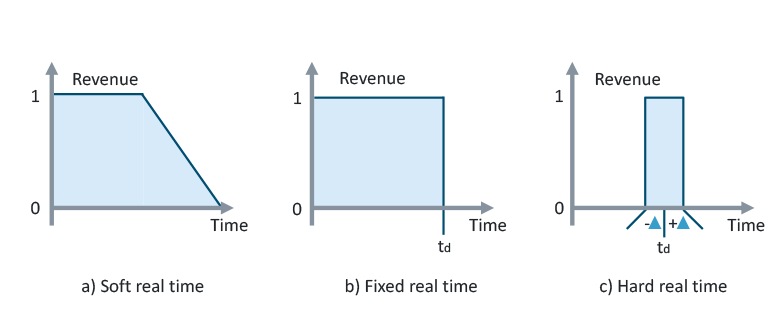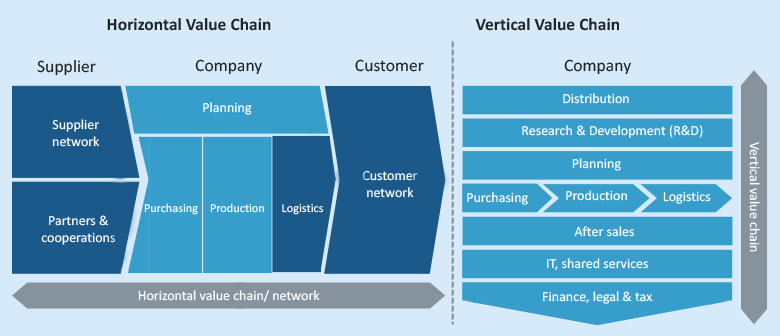Real Time 101 – The Basics

IT systems are increasingly becoming more intelligent, networked and autonomous. This digital transformation not only makes a company’s internal processes more efficient and transparent, it has a positive effect across the entire horizontal and vertical value chains. A key aspect of digitalisation is the ability to collect and process data in real time. In this first part of our blog series on real-time data, we look at the basics and answer the questions: What is real-time data and what is it used for?
What is real time?
ISO, an independent, non-governmental international organization of 167 national standards bodies defines real time as follows:
„Real time refers to operating a computing system in such a way that programmes for processing accruing data are constantly ready for operation and the results are available within a predetermined period of time. Depending on the application, the data may accrue randomly or at predetermined points in time.“[1]
Analysing this data helps to make your processes more transparent, make your planning more dependable and to recognise possible sources of error in time. The time window in which the data is collected is not fixed and can vary from a few milliseconds to several hours depending on the application in question.
Soft, firm, and hard real time
We differentiate between three specific types of real time based on the level of usefulness or criticality which information retains once a defined timespan has elapsed.
Soft real time
Soft real time means that a system is given a certain amount of time to complete a defined task. If it cannot meet this specification, the system can still run smoothly.
- Soft real time would be appropriate for something like drawing information from various connected systems into a product information management system (PIM) and then updating e-commerce channels with the new details on price, delivery time or availability. API integration is well suited to such challenging real-time processes.
- Another example of soft real time can be found in online banking. Here, there is a set time interval of ten seconds to complete transactions between payer and payee. However, if this is exceeded, this has no effect on the functioning of the system itself.
The international standard ISO 20022, payment integration for real-time payments enables banks and their customers to benefit from the advantages of real-time transactions. - E-Invoicing, in particular to tax authorities via continuous transaction controls (CTC), is also increasingly subject to real-time or near-real-time specifications. The concept of being “always on” is becoming one of the most important trends in digital tax enforcement.
Firm real time
With firm real time, there is a little leeway in the specified timespan. If a system cannot complete a task in the given timespan, the information becomes worthless. This causes errors. However, if these don’t occur too frequently, the system can still run reasonably smoothly.
- Firm real time is used for recording longer video sequences. If the video data is not stored fast enough on the data carrier, images may be lost and the video will not be available for many subsequent applications.
- A vehicle’s car navigation system uses a firm real-time specification for locating the vehicle’s current position. If the sat-nav is a little too slow, although the information then becomes worthless, there is still ample opportunity to correct the wrong route instructions.
- Another firm real-time scenario is using industrial data integration to monitor assembly and manufacturing processes. If an assembly error is detected too late, this may lead to a defective product. However, the assembly plant itself has not been damaged.
Hard real time
In contrast to soft and firm real time, hard real time contains no leeway. If the system doesn’t meet a deadline, this will have a critical impact on the system and possibly also the users.
- It is essential that the sensors controlling an airbag system transmit their data within milliseconds so that the airbag inflates immediately upon impact.
- In a nuclear power plant, control rods need to function in hard real time to avoid life-threatening and far-reaching nuclear incidents.
 Figure 1: Usefulness over time diagrams for real-time data[2]
Figure 1: Usefulness over time diagrams for real-time data[2]
Whether soft, firm or hard real time, the reactivity of a real-time system needs to be predictable and the system needs to be able to react to multiple, simultaneously occurring processes. You also need to protect the system from random events and other disruptions to keep it running safely and reliably.
How do you capture real-time data?
It goes without saying that in order to analyse, use and interpret real-time data, you first need to get it. One way to do this is through a sensor. This measures and records a certain value and then passes it on to a linked system which either uses or aggregates the data. However, to enable other systems to use this data, it needs to be in a format which is machine-readable and can be interpreted. Two established communication protocols in IoT and IIoT are MQTT (Message Queuing Telemetry Transport) and OPC UA (Open Platform Communications United Architecture).
Real time data – your key to success
Digitally transforming your business processes lets you share information in real time between all parties in your value creation network. This, in turn, improves the product as a whole. From the initial idea to sales, via development, production and delivery to the end customer, and ending in recycling and other end-of-lifecycle services, digitalisation creates a dynamic, self-organising cross-company value network, optimised in real time.
For most companies, implementing such scenarios means a transformation process lasting several years, which will ultimately lead to significant changes in value creation. In further blogs, we will present use cases in horizontal and vertical value chains.
 Figure 2: horizontal and vertical value creation chains
Figure 2: horizontal and vertical value creation chainsThese days, there are several new technologies and services available for collecting and processing data in real time. These have opened up new possibilities and give both large companies and SMEs the opportunity to optimise value chains and develop new business models. SEEBURGER can help you manage these changes at all levels of your company: from strategy to actual implementation at process, machine and plant level, through to a fully integrated digital value chain.
[1]Translated from German original https://de.wikipedia.org/wiki/Echtzeit, accessed 11.1.2022
[2] Source: https://www.uni-koblenz-landau.de/de/koblenz/fb4/ist/AGZoebel/Lehre/sommer2016/SeminarASidA/C2/at_download/file
Source: https://blog.seeburger.com/real-time-101-the-basics/
 industry-trend6.com
industry-trend6.com
